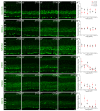Heterogeneous expression of the core circadian clock proteins among neuronal cell types in mouse retina
- PMID: 23189207
- PMCID: PMC3506613
- DOI: 10.1371/journal.pone.0050602
Heterogeneous expression of the core circadian clock proteins among neuronal cell types in mouse retina
Abstract
Circadian rhythms in metabolism, physiology, and behavior originate from cell-autonomous circadian clocks located in many organs and structures throughout the body and that share a common molecular mechanism based on the clock genes and their protein products. In the mammalian neural retina, despite evidence supporting the presence of several circadian clocks regulating many facets of retinal physiology and function, the exact cellular location and genetic signature of the retinal clock cells remain largely unknown. Here we examined the expression of the core circadian clock proteins CLOCK, BMAL1, NPAS2, PERIOD 1(PER1), PERIOD 2 (PER2), and CRYPTOCHROME2 (CRY2) in identified neurons of the mouse retina during daily and circadian cycles. We found concurrent clock protein expression in most retinal neurons, including cone photoreceptors, dopaminergic amacrine cells, and melanopsin-expressing intrinsically photosensitive ganglion cells. Remarkably, diurnal and circadian rhythms of expression of all clock proteins were observed in the cones whereas only CRY2 expression was found to be rhythmic in the dopaminergic amacrine cells. Only a low level of expression of the clock proteins was detected in the rods at any time of the daily or circadian cycle. Our observations provide evidence that cones and not rods are cell-autonomous circadian clocks and reveal an important disparity in the expression of the core clock components among neuronal cell types. We propose that the overall temporal architecture of the mammalian retina does not result from the synchronous activity of pervasive identical clocks but rather reflects the cellular and regional heterogeneity in clock function within retinal tissue.
Conflict of interest statement
Figures







Similar articles
-
Divergent roles of clock genes in retinal and suprachiasmatic nucleus circadian oscillators.PLoS One. 2012;7(6):e38985. doi: 10.1371/journal.pone.0038985. Epub 2012 Jun 11. PLoS One. 2012. PMID: 22701739 Free PMC article.
-
Quantification of interactions among circadian clock proteins via surface plasmon resonance.J Mol Recognit. 2014 Jul;27(7):458-69. doi: 10.1002/jmr.2367. J Mol Recognit. 2014. PMID: 24895278
-
Daily rhythmic expression patterns of clock1a, bmal1, and per1 genes in retina and hypothalamus of the rainbow trout, Oncorhynchus mykiss.Chronobiol Int. 2011 May;28(5):381-9. doi: 10.3109/07420528.2011.566398. Chronobiol Int. 2011. PMID: 21721853
-
[Molecular mechanisms of circadian clock functioning].Ukr Biokhim Zh (1999). 2011 May-Jun;83(3):5-24. Ukr Biokhim Zh (1999). 2011. PMID: 21888051 Review. Ukrainian.
-
AMPK at the crossroads of circadian clocks and metabolism.Mol Cell Endocrinol. 2013 Feb 25;366(2):163-9. doi: 10.1016/j.mce.2012.06.017. Epub 2012 Jun 28. Mol Cell Endocrinol. 2013. PMID: 22750052 Free PMC article. Review.
Cited by
-
Circadian rhythms in the Drosophila eye may regulate adaptation of vision to light intensity.Front Neurosci. 2024 May 30;18:1401721. doi: 10.3389/fnins.2024.1401721. eCollection 2024. Front Neurosci. 2024. PMID: 38872947 Free PMC article.
-
A standardized method to assess the endogenous activity and the light-response of the retinal clock in mammals.Mol Vis. 2020 Mar 4;26:106-116. eCollection 2020. Mol Vis. 2020. PMID: 32180677 Free PMC article.
-
Histamine Regulates Molecular Clock Oscillations in Human Retinal Pigment Epithelial Cells via H1 Receptors.Front Endocrinol (Lausanne). 2018 Mar 19;9:108. doi: 10.3389/fendo.2018.00108. eCollection 2018. Front Endocrinol (Lausanne). 2018. PMID: 29615980 Free PMC article.
-
Regulation of molecular clock oscillations and phagocytic activity via muscarinic Ca2+ signaling in human retinal pigment epithelial cells.Sci Rep. 2017 Mar 9;7:44175. doi: 10.1038/srep44175. Sci Rep. 2017. PMID: 28276525 Free PMC article.
-
Photoreceptor phagocytosis is mediated by phosphoinositide signaling.FASEB J. 2013 Nov;27(11):4585-95. doi: 10.1096/fj.13-237537. Epub 2013 Aug 2. FASEB J. 2013. PMID: 23913857 Free PMC article.
References
-
- Dunlap JC, Loros JJ, DeCoursey PJ (2003) Chronobiology. Biological Timekeeping. Sunderland, MA: Sinauer Associates, Inc. 406 p.
-
- Barlow R (2001) Circadian and efferent modulation of visual sensitivity. Prog Brain Res 131: 487–503. - PubMed
-
- Green CB, Besharse JC (2004) Retinal circadian clocks and control of retinal physiology. J Biol Rhythms 19: 91–102. - PubMed
-
- Iuvone PM, Tosini G, Pozdeyev N, Haque R, Klein DC, et al. (2005) Circadian clocks, clock-controlled genes and melatonin biosynthesis in the retina. Prog Retin Eye Res 24: 433–456. - PubMed
Publication types
MeSH terms
Substances
Grants and funding
LinkOut - more resources
Full Text Sources
Molecular Biology Databases

